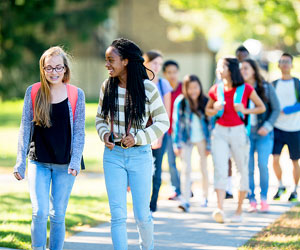Teens’ Memory for Faces Shifts Toward Peers During Puberty
 Adolescents begin to view faces differently as they prepare for the transition to adulthood, according to new research published in Psychological Science, a journal of the Association for Psychological Science.
Adolescents begin to view faces differently as they prepare for the transition to adulthood, according to new research published in Psychological Science, a journal of the Association for Psychological Science.
“We know that faces convey a lot of different social information, and the ability to perceive and interpret this information changes through development,” explained psychological scientist Suzy Scherf of Penn State, senior author on the study. “For the first time, we’ve been able to show how puberty, not age, shapes our ability to recognize faces as we grow into adults.”
According to Scherf, this retuning of the face processing system, from showing a bias toward adult female faces as children, to preferring peer faces that match their own developmental stage in puberty, is part of the social metamorphosis that prepares adolescents to take on adult social roles. “In other words, it literally changes the way people see faces. This has been shown previously in research published in animal literature, but not in humans.”
Scherf and graduate student Giorgia Picci developed an innovative experimental design that proves a bias to remember peer faces is reflected in the pubertal stage of the face, rather than the age of the face, which is how previous researchers investigated these biases. “We were able to show that puberty shapes the subtle emergence of social behaviors that are important for adolescents’ transition to adulthood. This likely happens due to hormones influencing the brain and the nervous system reorganization that occurs during this time,” said Scherf.
The researchers recruited 116 adolescents and young adults for the study and separated them into four pubertal groups depending on their stage of puberty. Importantly, the adolescents in the study were all the same age, but differed in their stage of puberty. Therefore, any differences in the way they responded to faces were related to their pubertal status, not their age. Scherf and Picci determined the adolescents’ stage of development through self-assessments as well as parent-provided assessments.
The researchers presented participants with 120 gray-scale photographs of male and female faces. The pubertal status of the faces in the pictures matched that of the participants. “In other words, there were images of pre-pubescent children, young adolescents in early puberty, young adolescents in later puberty, and sexually mature young adults,” Scherf explained.
Participants were asked to look at faces from all four pubertal groups, and the researchers measured their face-recognition ability using a computerized game. After studying 10 target faces with neutral expressions, participants were shown another set of 20 faces with happy expressions and had to identify whether they had seen each face previously or if they were new.
Scherf and Picci found that the pre-pubescent children had a bias to remember adult faces, which they call the caregiver bias. “This is interesting because these are school-age children who spend lots of time with other children, yet they are still biased to remember adult faces,” said Scherf.
In contrast, adolescents had a bias to remember other adolescent faces, exhibiting a peer bias. According to Scherf, the most surprising finding was that among adolescents who were the same age, those who were less mature in pubertal development had better recognition memory for other similarly less mature adolescents, while those who were more mature in pubertal development had better recognition memory for peers who were similar in their level of development.
“This shows that adolescents are very clued into each other’s pubertal status. They can literally see it in each other’s faces, perhaps implicitly, and this influences how they keep track of each other. This may explain a well-known finding that adolescents organize their peer groups according to pubertal status and is relevant for understanding how adolescents begin to think about each other as romantic partners for the first time.”
This research will help scientists uncover how puberty impacts the developing human brain and help them understand the timetable of behavioral and brain changes during adolescence, which could guide mental health treatment and inform public health policy. In the future, Scherf and Picci plan to further investigate face processing changes that occur during puberty.
This work was supported by the Social Science Research Institute, the Pennsylvania State University Department of Psychology, and a National Science Foundation Graduate Research Fellowship (No. DGE1255832).





APS regularly opens certain online articles for discussion on our website. Effective February 2021, you must be a logged-in APS member to post comments. By posting a comment, you agree to our Community Guidelines and the display of your profile information, including your name and affiliation. Any opinions, findings, conclusions, or recommendations present in article comments are those of the writers and do not necessarily reflect the views of APS or the article’s author. For more information, please see our Community Guidelines.
Please login with your APS account to comment.